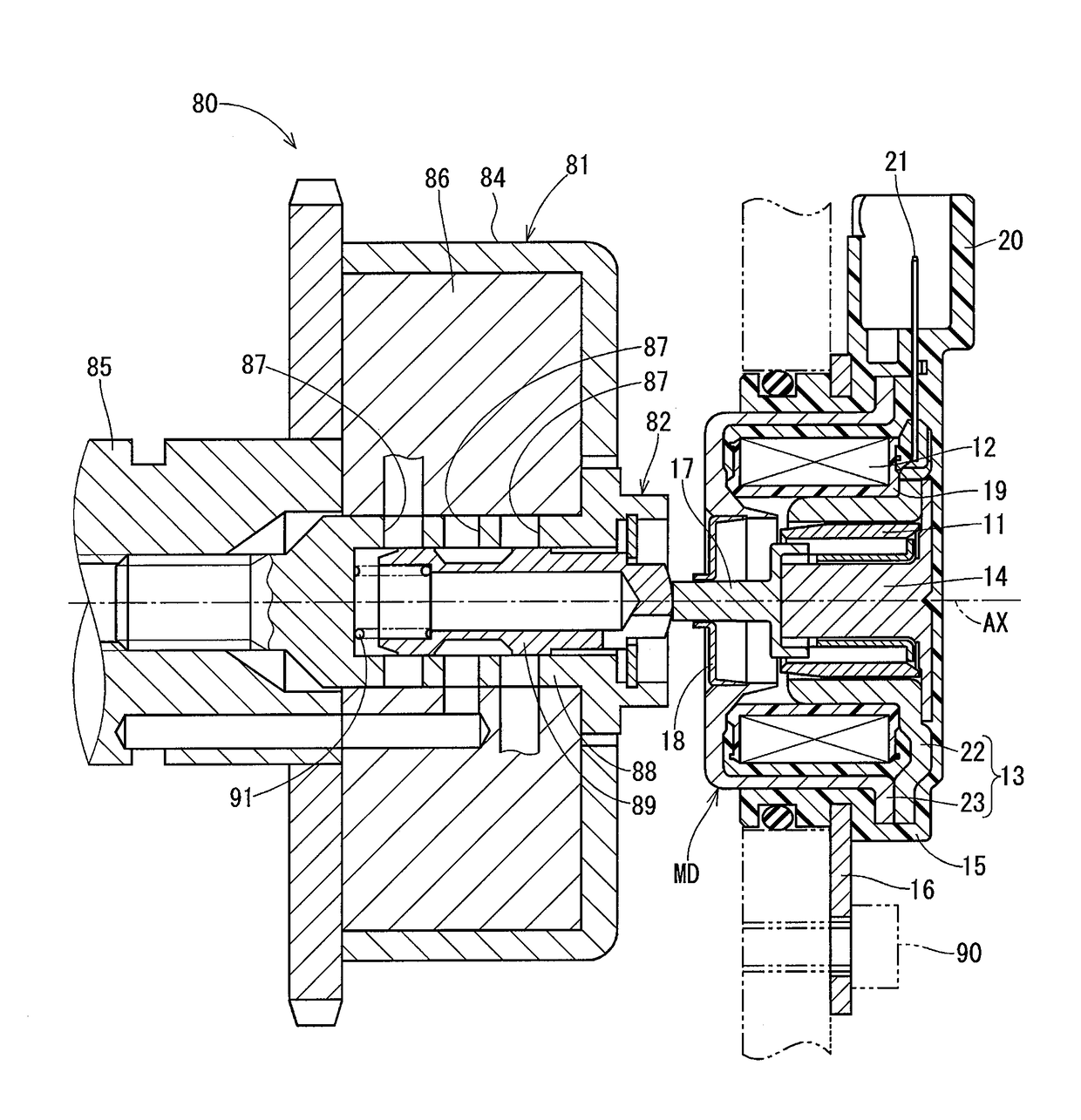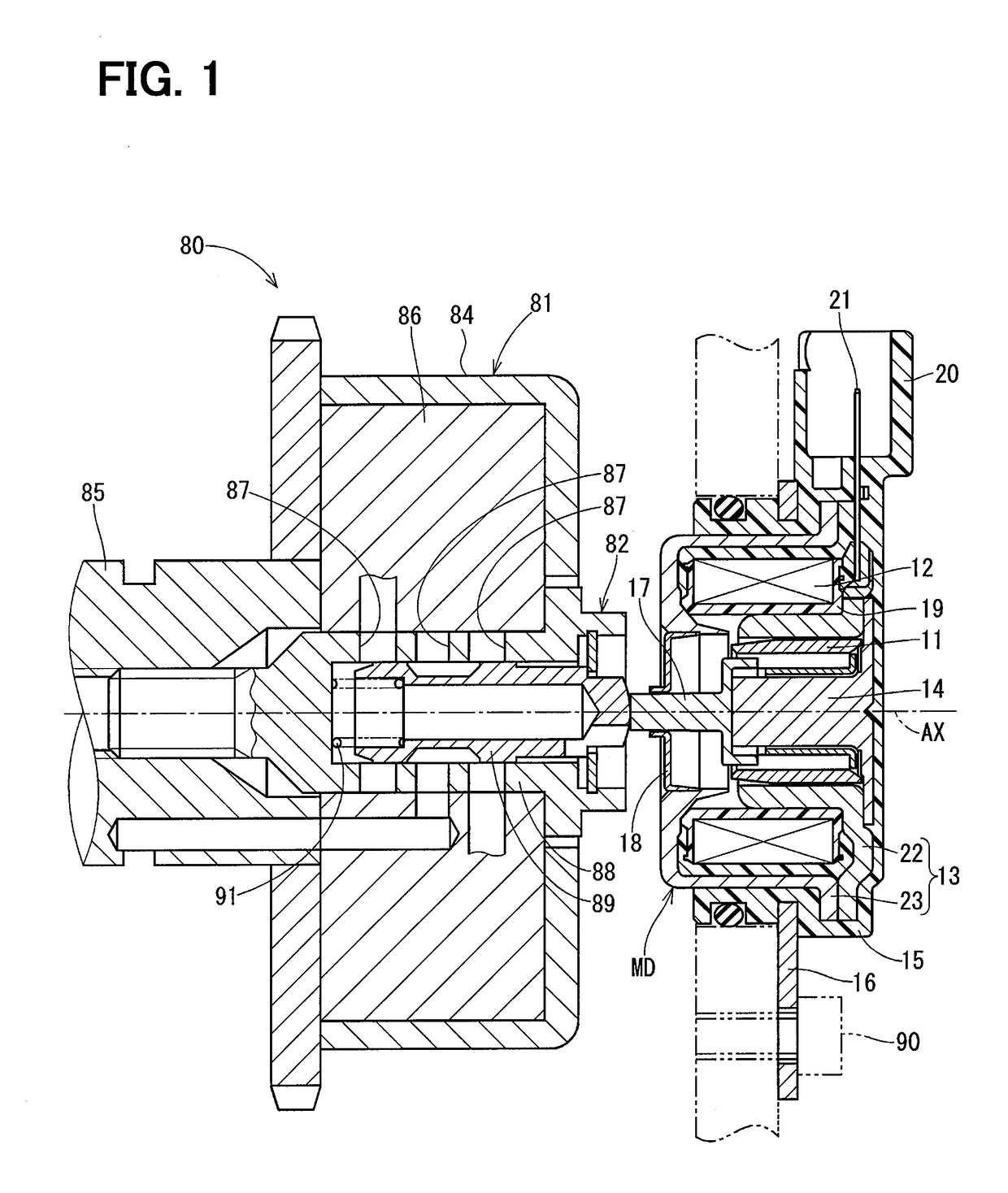Electromagnetic actuator
- Summary
- Abstract
- Description
- Claims
- Application Information
AI Technical Summary
Benefits of technology
Problems solved by technology
Method used
Image
Examples
first embodiment
[0036]An electromagnetic actuator according to a first embodiment of the present disclosure is applied to a valve timing adjuster system 80 of an engine shown in FIG. 1. The valve timing adjuster system 80 includes a valve timing adjuster device 81 and an oil pressure control valve 82.
[0037]The valve timing adjuster device 81 includes a housing 84, which is rotated synchronously with a crankshaft of the engine, and a vane rotor 86, which is rotated integrally with a camshaft 85 of the engine. Valve timing of intake valves or exhaust valves of the engine can be adjusted by changing a relative rotational phase between the housing 84 and the vane rotor 86. The vane rotor 86 is rotated relative to the housing 84 according to a degree of an oil pressure of oil pressure chambers (advancing chambers, retarding chambers) formed in an inside of the housing 84. The oil pressure of the oil pressure chambers is adjusted by an oil pressure control valve 82 that is placed at a center part of the ...
second embodiment
[0076]In a second embodiment of the present disclosure, as shown in FIG. 8, the outer wall surface 50 is tapered in an axial range, which is from the first proximal end side specific point Pk1 to the first distal end side specific point Ps1. A portion of the outer wall surface 50, which is located on the distal end 44 side of the first distal end side specific point Ps1, is parallel with the axial direction, and another portion of the outer wall surface 50, which is located on the proximal end 43 side of the first proximal end side specific point Pk1, is parallel with the axial direction. Even when the portion of the outer wall surface 50 is tapered, the reduction of the frictional force between the rod 17 and the support tubular portion 32 and the reduction of the amount of swing of the distal end 44 of the rod 17 in the radial direction can be both achieved in comparison to the first and second comparative examples.
third embodiment
[0077]In a third embodiment of the present disclosure, as shown in FIG. 9, the outer wall surface 60 is shaped into a stepped form such that the diameter of the rod 17 is reduced in stepwise manner at predetermined intervals from the proximal end 43 side toward the distal end 44 side. The intervals, at each of which the diameter of the rod 17 is reduced, may be freely set. In the present embodiment, the outer wall surface 60 is sequentially stepped in a form of stairs throughout the entire range, which is from the proximal end 43 to the distal end 44. Even with this rod, which is shaped into the sequentially stepped form, the clearance CB, which is formed when the rod 17 is placed in the maximum projected position, is smaller than the clearance CA, which is formed when the rod 17 is placed in the maximum retracted position. Thus, advantages, which are similar to those of the first embodiment, can be achieved.
PUM
 Login to View More
Login to View More Abstract
Description
Claims
Application Information
 Login to View More
Login to View More - R&D
- Intellectual Property
- Life Sciences
- Materials
- Tech Scout
- Unparalleled Data Quality
- Higher Quality Content
- 60% Fewer Hallucinations
Browse by: Latest US Patents, China's latest patents, Technical Efficacy Thesaurus, Application Domain, Technology Topic, Popular Technical Reports.
© 2025 PatSnap. All rights reserved.Legal|Privacy policy|Modern Slavery Act Transparency Statement|Sitemap|About US| Contact US: help@patsnap.com



